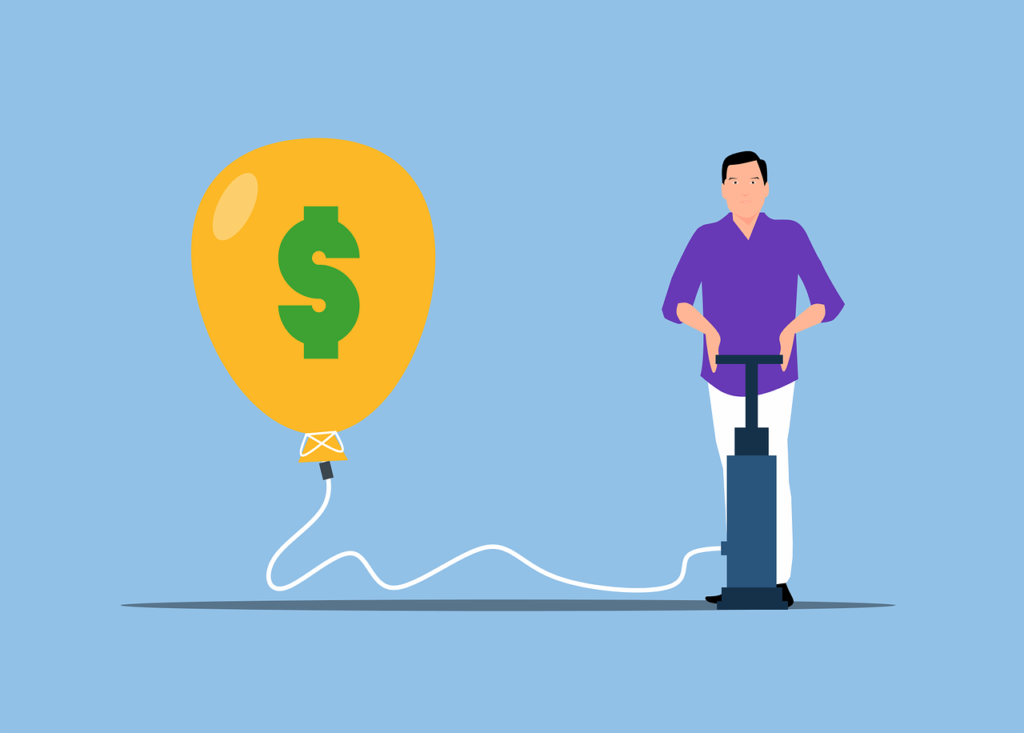
What is Economic Inflation?
Economic inflation refers to the gradual erosion of purchasing power over time, manifesting as a broad upward trend in prices for goods and services. In simpler terms, it’s a phenomenon where your money can’t buy as much today as it could yesterday. This steady rise in the overall cost of living is a normal facet of economic cycles observed across nations worldwide.
Contrary to popular belief, inflation isn’t limited to price surges for specific commodities. Rather, it signifies a simultaneous and sustained increase in costs across most aspects of consumer expenditure from groceries and utilities to housing and transportation. As prices climb, each unit of currency loses value, diminishing your ability to acquire the same basket of goods and services.
Measuring the Rate of Inflation
To quantify inflation, statistical agencies calculate price indices that track changes in the cost of a representative bundle of consumer purchases over time. The two predominant metrics are:
- Consumer Price Index (CPI): Computed by the Bureau of Labor Statistics, the CPI measures out-of-pocket expenses for urban consumers across categories like food, housing, apparel, transportation, medical care, and recreation.
- Personal Consumption Expenditures (PCE) Price Index: Published by the Bureau of Economic Analysis, the PCE incorporates a broader range of consumer spending, including healthcare costs. It’s weighted using business survey data for enhanced accuracy.
By comparing these indices across different time periods month-over-month or year-over-year economists can derive the corresponding rates of inflation. Any sustained increase beyond 2% is generally viewed as a cause for concern by policymakers.
Economic Impacts: The Good, the Bad, and the Ugly
While moderate inflation around 2% is considered healthy, deviations from this optimal range can have far-reaching implications for consumers, businesses, and the overall economy.
The Upside of Low Inflation
Mild inflation can stimulate spending and spur economic growth during periods of stagnation. When prices rise gradually, consumers have an incentive to make purchases sooner rather than later, boosting demand and productivity. This environment also allows for smoother adjustments to wages, interest rates, and contractual obligations tied to inflation.
The Downside of High Inflation
However, when inflation exceeds wage growth for an extended period, it can severely erode purchasing power and living standards. Some key consequences include:
- Diminished Real Incomes: As the costs of essentials like food, energy, and housing outpace income growth, households find their budgets increasingly strained.
- Uneven Wealth Redistribution: Inflation transfers wealth from creditors to debtors by reducing the real value of outstanding loans and fixed-income assets. This disproportionately impacts retirees and others relying on fixed incomes.
- Speculative Behavior: In anticipation of further price hikes, consumers may hoard goods, exacerbating shortages and fueling a vicious inflationary cycle.
- Economic Instability: Sustained high inflation can undermine business confidence, discourage investment, and ultimately stifle long-term economic growth.
The Perils of Deflation
While less common, deflation a sustained decline in the overall price level can be equally detrimental. As purchasing power increases, consumers tend to delay spending in anticipation of even lower prices, depressing demand. This deflationary spiral can lead to rising unemployment, stagnant wages, and a recession.
Moreover, deflation increases the real burden of outstanding debt, as loan repayments become more expensive relative to incomes and asset values. This dynamic can trigger defaults, jeopardizing the stability of the financial system.
Catalysts of Inflation: Demand-Pull and Cost-Push Factors
Understanding the root causes of inflation is crucial for policymakers to formulate effective mitigation strategies. Economists broadly categorize inflationary pressures into two types:
Demand-Pull Inflation
This phenomenon arises when aggregate demand for goods and services outstrips the economy’s production capacity, leading to shortages and upward pressure on prices. Some common triggers include:
- Robust Consumer Spending: Periods of low unemployment, rising wages, and high consumer confidence can fuel excessive demand for various products and services.
- Expansionary Fiscal and Monetary Policies: Tax cuts, increased government spending, and low interest rates can stimulate economic activity beyond the economy’s potential output, overheating demand.
- Speculative Asset Bubbles: Rapid price appreciation in markets like real estate or stocks can create a “wealth effect,” prompting households to increase consumption expenditure.
Cost-Push Inflation
In contrast, cost-push inflation originates from supply-side shocks that drive up production costs, forcing businesses to raise prices to preserve profit margins. Key contributors include:
- Rising Input Costs: Spikes in prices for raw materials (e.g., oil, agricultural commodities), intermediate goods, or wages can escalate overall production expenses.
- Supply Chain Disruptions: Events like natural disasters, geopolitical conflicts, or trade disputes can restrict the availability of crucial inputs, constricting supply.
- Monopolistic Pricing Power: Firms with substantial market dominance may exploit their position to raise prices without justification from increased costs.
It’s worth noting that these catalysts often interact and reinforce each other. For instance, supply shocks can trigger an initial wave of cost-push inflation, which then fuels public expectations of further price increases, amplifying demand-pull pressures.
Inflationary Expectations: A Self-Fulfilling Prophecy
Inflation dynamics are heavily influenced by public perceptions and anticipations a phenomenon known as “inflationary expectations.” When households and businesses expect prices to keep rising, they tend to modify their behavior accordingly:
- Wage Demands: Workers may demand higher compensation to maintain their standard of living, raising labor costs for businesses.
- Pricing Strategies: Companies often preemptively increase prices to protect future profit margins, even before costs escalate.
- Spending Patterns: Consumers might accelerate major purchases to avoid anticipated price hikes, fueling demand-pull pressures.
These behavioral shifts can become self-reinforcing, embedding inflation into the fabric of the economy through wage-price spirals and entrenched expectations. Anchoring public confidence in the central bank’s commitment to price stability is therefore crucial for policymakers.
Historical Inflationary Episodes and Their Legacies
While inflation is a recurrent economic phenomenon, certain periods stand out for their severity and lasting impacts:
- The Great Inflation (1965-1982): This protracted episode of double-digit inflation in the United States, peaking at nearly 15% in 1980, prompted the Federal Reserve to raise interest rates to unprecedented levels. The experience underscored the importance of credible monetary policy in preserving price stability.
- Hyperinflation in Zimbabwe (2008): At its peak, Zimbabwe experienced an annual inflation rate estimated at 500 billion percent, rendering the local currency virtually worthless. This catastrophic episode highlighted the dangers of unchecked money printing to finance government deficits.
- The Commodity Boom (2000s): Rapidly rising demand from emerging economies, coupled with supply constraints, drove up global prices for energy, food, and raw materials. This period demonstrated how external shocks can propagate inflation across borders through integrated supply chains.
Such historical episodes serve as cautionary tales, reinforcing the imperative for policymakers to remain vigilant against inflationary risks and to maintain well-anchored public expectations.
The Role of Monetary Policy in Taming Inflation
Central banks play a pivotal role in managing inflation through their control over the money supply and interest rates. The primary tools at their disposal include:
- Interest Rate Adjustments: By raising benchmark interest rates, central banks aim to curb borrowing and dampen consumer spending, alleviating demand-pull pressures. Conversely, lowering rates can stimulate economic activity during periods of low inflation or deflation.
- Open Market Operations: Central banks can influence money supply and credit conditions by buying or selling government securities in the open market. Reducing the money supply helps constrain inflationary pressures.
- Reserve Requirements: Increasing the percentage of deposits that banks must hold as reserves limits their ability to create new loans and money, restraining credit growth and inflationary pressures.
- Inflation Targeting: Many central banks now explicitly adopt numerical inflation targets, typically around 2%, and adjust policies to steer actual inflation towards that goal. This approach enhances transparency and anchors public expectations.
However, the effects of monetary policy can take considerable time to permeate the economy, necessitating a forward-looking and preemptive approach by central bankers. Moreover, the efficacy of these tools depends on the specific inflationary dynamics at play and the credibility of the central bank’s commitment to price stability.
The Fiscal Policy Dimension: Taxes, Spending, and Debt Management
While monetary policy is the primary line of defense against inflation, fiscal policy the government’s approach to taxation, spending, and debt management can also play a complementary role:
- Expenditure Adjustments: Reducing non-essential government spending can help alleviate demand-pull pressures by curtailing aggregate demand in the economy.
- Targeted Transfers: Providing temporary, means-tested financial support to vulnerable segments of the population can mitigate the regressive impact of inflation on lower-income households.
- Debt Management: Prudent debt management, including the issuance of inflation-indexed bonds, can help insulate public finances from the eroding effects of unanticipated inflation.
- Structural Reforms: Policies that enhance productivity, competitiveness, and labor force participation can boost the economy’s potential output, easing supply constraints that contribute to cost-push inflation.
However, the effectiveness of fiscal policy in curbing inflation hinges on the credibility of the government’s long-term commitment to fiscal discipline and debt sustainability. Excessive reliance on deficit financing or monetizing debt can exacerbate inflationary pressures, particularly if it undermines public confidence in the central bank’s independence.
Sectoral Impacts: Varied Experiences Across Industries
While inflation is a macroeconomic phenomenon, its effects can manifest differently across sectors and industries, necessitating tailored mitigation strategies:
Consumer Goods and Services
- Food and Beverages: As essential items, food and beverage prices tend to be sticky and rise rapidly during inflationary periods, disproportionately impacting lower-income households.
- Housing and Utilities: Rising costs for shelter, electricity, and heating can severely strain household budgets, prompting calls for targeted relief measures.
- Discretionary Spending: Luxury goods, entertainment, and non-essential services may experience demand contraction as consumers prioritize necessities.
Industrial and Manufacturing
- Raw Materials: Producers of commodities like energy, metals, and agricultural products may benefit from rising prices, while downstream industries face higher input costs.
- Durable Goods: Industries like automotive and appliances may see demand volatility as consumers defer major purchases in anticipation of further price hikes.
- Pricing Power: Firms with strong brand loyalty and pricing power may find it easier to pass through cost increases to consumers without significant volume losses.
Financial Services
- Banking: Rising interest rates can boost lending profitability but also increase the risk of defaults on variable-rate loans and mortgages.
- Insurance: Inflationary pressures can erode the real value of fixed-income investments and necessitate premium adjustments to maintain solvency.
- Asset Management: Periods of high inflation can disrupt traditional asset allocation models and spur demand for inflation-hedging instruments like commodities or real estate.
Healthcare and Pharmaceuticals
- Service Providers: Labor-intensive healthcare services may experience significant cost pressures due to wage inflation, potentially straining affordability.
- Pharmaceuticals: While benefiting from pricing power, drug manufacturers may face higher costs for research, production, and distribution.
- Health Insurance: Premium increases may be necessary to maintain actuarial soundness, potentially exacerbating accessibility challenges.
Recognizing these nuanced impacts is crucial for businesses and policymakers to craft targeted strategies that address sector-specific vulnerabilities and opportunities.
Protecting Personal Finances: Practical Tips for Consumers
While businesses grapple with strategic responses, individual consumers can also take proactive steps to mitigate the impact of inflation on their personal finances:
- Budget Vigilance: Regularly review and adjust budgets to account for rising costs, prioritizing essential expenses and identifying areas for potential cost-cutting.
- Debt Management: Prioritize paying off variable-rate debts like credit cards and adjustable-rate mortgages to minimize the impact of rising interest rates.
- Diversified Investments: Explore investment vehicles that can serve as inflation hedges, such as real estate, commodities, or inflation-protected securities (TIPS).
- Lifestyle Adjustments: Adopt energy-efficient practices, reduce discretionary spending, and explore cost-saving alternatives for transportation, entertainment, and dining out.
- Negotiation and Bargaining: Leverage market competition to negotiate better rates for services like cable, internet, and insurance, or explore bundling options.
- Income Diversification: Explore opportunities for additional income streams, side gigs, or skills development to enhance earning potential and financial resilience.
- Emergency Funds: Maintain a well-funded emergency savings account to weather unexpected expenses or temporary income disruptions during inflationary periods.
By adopting a proactive and disciplined approach to personal finance management, consumers can better insulate themselves from the erosive effects of inflation on their purchasing power and long-term financial well-being.
The Future of Inflation: Challenges and Uncertainties
While the current inflationary surge may subside, the global economy faces several long-term challenges that could reignite inflationary pressures in the future:
- Demographic Shifts: Aging populations in many developed economies could exacerbate labor shortages, driving up wage costs and inflationary pressures.
- Deglobalization and Reshoring: A potential reversal of globalization trends, driven by geopolitical tensions or supply chain resilience concerns, could increase production costs and disrupt global supply chains.
- Climate Change and Environmental Disruptions: The intensifying impacts of climate change, such as extreme weather events, could disrupt agricultural production, energy supplies, and critical infrastructure, leading to supply shocks and cost-push inflation.
- Technological Disruptions: The rapid pace of technological change, including the adoption of artificial intelligence and automation, could reshape labor markets and production dynamics in ways that challenge traditional inflation models.
- Central Bank Credibility: A potential erosion of public trust in central banks’ commitment to price stability could destabilize inflationary expectations and complicate policy responses.
- Fiscal Sustainability Concerns: Rising public debt levels and unfunded liabilities in many economies could constrain the ability of governments to provide targeted fiscal support during inflationary episodes.
Navigating these challenges will require a coordinated effort from policymakers, businesses, and individuals to enhance economic resilience, foster sustainable growth, and maintain well-anchored inflationary expectations.
Economic inflation is a complex and multifaceted phenomenon that permeates all aspects of the modern economy. While moderate levels can be beneficial, deviations from price stability can have far-reaching consequences for consumers, businesses, and the overall economic landscape Mastering the dynamics of inflation and its root causes is essential for policymakers to craft effective mitigation strategies and maintain economic stability. Central banks play a pivotal role through their control over monetary policy levers like interest rates and money supply, while governments can provide complementary support through prudent fiscal policies and structural reforms.
Individual consumers, too, must remain vigilant and adapt their personal finance strategies to preserve purchasing power and long-term financial well-being. This may involve lifestyle adjustments, debt management, diversified investments, and a disciplined approach to budgeting and saving.
Looking ahead, the global economy faces a myriad of challenges that could reignite inflationary pressures, ranging from demographic shifts and deglobalization trends to the disruptive impacts of climate change and technological advancements. Addressing these challenges will require a coordinated effort from all stakeholders, fostering economic resilience, sustainable growth, and well-anchored inflationary expectations.
Ultimately, the pursuit of price stability is an ongoing endeavor, one that necessitates a deep understanding of the intricate interplay between economic forces, policy actions, and societal dynamics. By embracing this complexity and remaining vigilant against inflationary risks, we can pave the way for a more prosperous and stable economic future for all.






